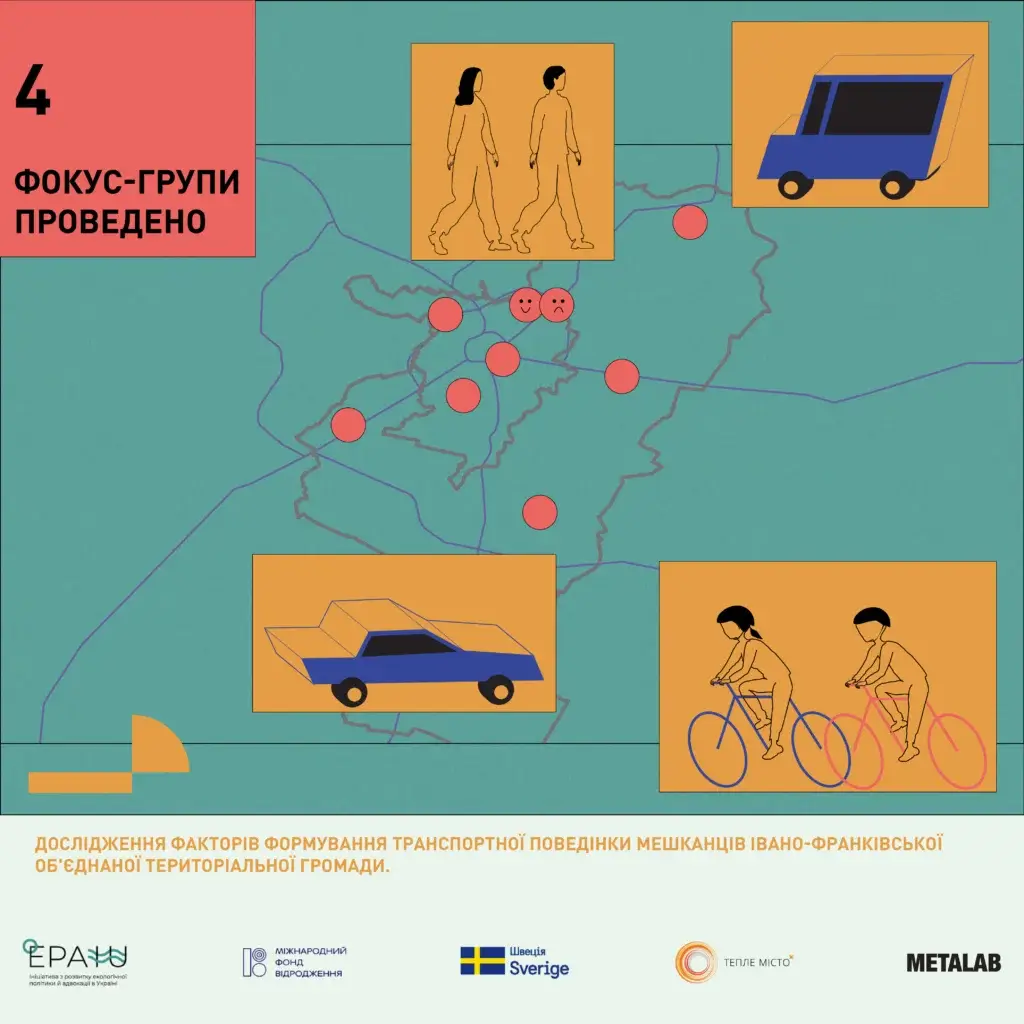TOPIC: URBAN ECONOMY FORMAT: research, publication
TIME: 2021-2022
INVOLVED: Marta Buryak, Yuliia Popova, Viktor Zagreba (authors), Olesia Storozhuk, Mariia Melinyshyn (proofreading), Yulia Rusylo (design and layout)
PARTNERS: Teple Misto, International Renaissance Foundation with financial support from Sweden, Center for International Migration and Development
Since November 2021, the METALAB team and the Teple Misto platform have analyzed the mobility behavior of Frankivsk residents and studied what influences their decisions about traveling around the city. When the data collection was almost complete, the war interrupted the process and called into question the relevance of the results. After all, due to the arrival of a large number of internally displaced persons (IDPs), the relocation of businesses to Ivano-Frankivsk, and, at the same time, the departure of local residents abroad, the demographic structure of the city and community has undergone significant changes. This demographic growth has directly impacted the mobility situation in the city and, thus, necessitates further research.
What is transportation behavior? Basically, it is a user’s choice of a particular mode of transportation or a combination of different modes under different conditions. However, it is just a matter of personal preference, but rather a relatively stable tendency to travel specific routes in a certain proven way. These behavioral patterns are shaped by different preferences, habits, personal experiences, financial capabilities, and objective factors of space and infrastructure. In the study, we explore the main factors that influence the mobility behavior of different groups of Ivano-Frankivsk residents, their usage patterns of various transportation modes, and the barriers that hinder sustainable mobility, along with its potential.
Despite the city’s compact scale and short distances, demand for car use, mainly used ones, is growing in Ivano-Frankivsk. This has several negative consequences for the environment and public health and reduces the quality of life in general. Our study hypothesizes that urban space is losing its attractiveness for walking or using light personal transport precisely because of the need for systemic support for sustainable mobility and an understanding of the factors that influence the transport choices of residents at the city and community levels. This works in conjunction with a number of other reasons, which is why we studied the motivation of different population groups to use different modes of transportation.
Although our study reflects the status quo as of February 2022, it will be practical for many reasons.
First, it identifies and describes general trends in transportation behavior for Ivano-Frankivsk and the community that are likely to be strengthened rather than dramatically changed. We highlight issues with the city’s infrastructure and planning, which lead to unsustainable mobility patterns that do not align with the principles of a circular economy.
Secondly, the study addresses the issue of mobility behavior, which has generally received insufficient attention in both the academic literature and urban planning practices. For instance, only a few Ukrainian cities have analyzed the so-called “modal share,” which refers to using different modes of transport in their residents’ daily commutes. It is based on such an analysis that patterns of transportation behavior can be identified and sustainable mobility strategies can be developed, which over time can positively impact air quality and the environment in the city. Our study conceptualizes the issue of mobility behavior and offers an example of an analytical approach to studying this topic.
Thirdly, understanding the pre-war status quo is essential to anticipate dynamics, strengthen existing capacities, and avoid increasing current risks.
Thus, this study aimed to identify the factors shaping the mobility behavior of residents of the Ivano-Frankivsk territorial community and to create recommendations for updating city policies that will facilitate the transition from car use to walking or light private (bicycles, electric scooters, etc.) or public transport.
In response to the circumstances of the full-scale war, the project team amended its plans. We worked on an additional analysis of the transport situation in the Ivano-Frankivsk community in the context of the war and the reception of internally displaced persons. Based on this analysis, the team prepared Recommendations for the Integrated Development of the Ivano-Frankivsk Urban Agglomeration and Reducing the Environmental Impact of Transport.


















